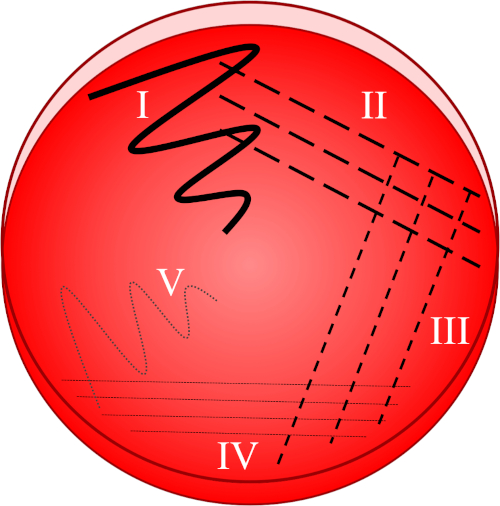Pure Cultures and Streak Plating: Isolation of Single Bacterial Colonies from a Mixed Sample
Overview
Source: Tilde Andersson1, Rolf Lood1
1 Department of Clinical Sciences Lund, Division of Infection Medicine, Biomedical Center, Lund University, 221 00 Lund, Sweden
Seemingly impossible to determine, microbial biodiversity is truly astounding with an estimated one trillion coexisting species (1,2). Although particularly harsh climates, like the acidic environment of the human stomach (3) or the subglacial lakes of Antarctica (4), may be dominated by a specific species, bacteria are typically found in mixed cultures. As each strain may influence the growth of another (5), the ability to separate and cultivate "pure" (consisting only of one type) colonies has become essential in clinical and academic settings alike. Pure cultures enable further genetic (6) and proteomic examinations (7), analysis of sample purity and, perhaps more noteworthy, the identification and characterization of infectious agents from clinical samples.
Bacteria have a wide range of growth requirements and there are numerous types of nutrient media designed to sustain both the un-demanding and the fastidious species (8). Growth media can be prepared either in liquid form (as a broth) or in a typically agar-based (a gelling agent derived from red algae) solid form. Whereas direct inoculation into broth carries the risk of generating a genetically diverse or even mixed bacterial population, plating and re-streaking creates a purer culture where each cell has a highly similar genetic makeup. The streak plate technique is based on progressive dilution of a sample (Figure 1), with the aim of separating individual cells from one another. Any viable cell (hereafter referred to as a colony forming unit, CFU) sustained by the media and designated environment can subsequently found an isolated colony of daughter-cells through binary fission. In spite of the rapid mutation rates within bacterial communities, this cell-group is generally regarded as clonal. Harvesting and re-streaking this population consequently ensures that subsequent work involves only a single bacterial type.

Figure 1: A streak plate is based on progressive dilution of the original sample. I) The inoculum is initially dispersed using a zig-zag motion, creating an area with a relatively dense bacterial population. II-IV) Streaks are drawn from the preceding area, using a sterile inoculation loop each time, until the fourth quadrant is reached. V) A final zig-zag motion directed towards the middle of the plate forms a region where the inoculum has been markedly diluted, allowing colonies to appear separate from one another.
The streak plate technique can also be combined with the use of selective and/or differential media. A selective medium will inhibit the growth of certain organisms (e.g. through addition of antibiotics) whilst a differential medium will solely help distinguish one from another (e.g. through hemolysis on blood agar plates).
Underlying all work in microbiology is the use of aseptic (sterile) techniques. Every bacterial culture should be considered potentially pathogenic as there is a risk of unintended growth of treacherous strains, aerosol formation and contamination of equipment/personnel. To minimize these risks, all media, plastic-, metal- and glass-ware are typically sterilized through autoclaving before and after use, subjecting them to high-pressure saturated steam at around 121°C that effectively wipes out any lingering cells. The work space is generally disinfected using ethanol both prior to, and after, use. Lab coat and gloves are always worn during work with infectious agents.
Procedure
1. Set up
- All microbes should be treated as if they are hazardous. Always wear a lab coat and gloves, tie back long hair, and ensure that any wounds are particularly well protected.
- Ready the work space by sterilizing it using 70% ethanol.
- Ensure that agar plates, sample solution(s) and either a box of pre-sterilized plastic inoculation loops or a metal loop plus a Bunsen flame, are close at hand. Disposable, plastic loops are typically pre-sterilized. Metal loops should b
Results
The initial streak-plate may contain colonies originating from cells with different genetic makeup or (depending on sample purity) from different bacterial species (Figure 2A).
Through subsequent isolation of a single colony, where all units are derived from a common mother-cell, the second streaking procedure generates a relatively clonal bacterial population, suitable for further
Application and Summary
The ability to obtain and cultivate a pure bacterial colony is essential, both in clinical and academic settings. Streak plating enables the isolation of a relatively clonal cell population, originating from a shared CFU, that may be of particular interest during diagnosis or for additional characterization of the isolate. A sample is streaked onto a suitable agar-based nutrient medium and incubated until colonies become visible. An isolated colony is subsequently harvested and re-streaked onto a second plate.
Tags
Skip to...
Videos from this collection:

Now Playing
Pure Cultures and Streak Plating: Isolation of Single Bacterial Colonies from a Mixed Sample
Microbiology
166.8K Views

Creating a Winogradsky Column: A Method to Enrich the Microbial Species in a Sediment Sample
Microbiology
130.4K Views

Serial Dilutions and Plating: Microbial Enumeration
Microbiology
317.7K Views

Enrichment Cultures: Culturing Aerobic and Anaerobic Microbes on Selective and Differential Medias
Microbiology
132.5K Views

16S rRNA Sequencing: A PCR-based Technique to Identify Bacterial Species
Microbiology
190.2K Views

Growth Curves: Generating Growth Curves Using Colony Forming Units and Optical Density Measurements
Microbiology
298.9K Views

Antibiotic Susceptibility Testing: Epsilometer Tests to Determine MIC Values of Two Antibiotics and Evaluate Antibiotic Synergy
Microbiology
94.3K Views

Microscopy and Staining: Gram, Capsule, and Endospore Staining
Microbiology
364.6K Views

Plaque Assay: A Method to Determine Viral Titer as Plaque Forming Units (PFU)
Microbiology
186.9K Views

Transformation of E. coli Cells Using an Adapted Calcium Chloride Procedure
Microbiology
87.3K Views

Conjugation: A Method to Transfer Ampicillin Resistance from Donor to Recipient E. coli
Microbiology
38.5K Views

Phage Transduction: A Method to Transfer Ampicillin Resistance from Donor to Recipient E. coli
Microbiology
29.3K Views
Copyright © 2025 MyJoVE Corporation. All rights reserved